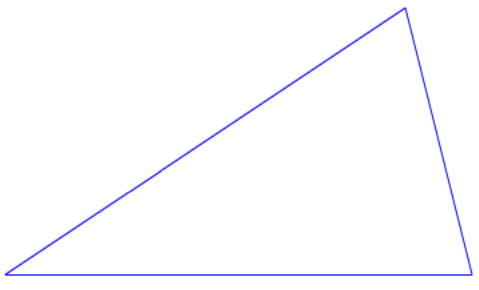Looking back at each other
 If the perimeter of a triangle is
8
, find the maximum possible value of its area.
If the perimeter of a triangle is
8
, find the maximum possible value of its area.
This section requires Javascript.
You are seeing this because something didn't load right. We suggest you, (a) try
refreshing the page, (b) enabling javascript if it is disabled on your browser and,
finally, (c)
loading the
non-javascript version of this page
. We're sorry about the hassle.
4 solutions
Good solution !!
Pls elaborate this AM GM thing
Log in to reply
First and foremost thing about A.M G.M H.M inequality is it is defined only for positive reals.
A.M-arithmetic mean,G.M-geometric mean,H.M-harmonic mean
A.M G.M H.M inequality for a,b,terms where a,b ∈ positive reals
2 a + b ≥ 2 a b ≥ a 1 + b 1 2
Log in to reply
Oh!! Thank you so much!!
It is Arithematic mean geometric mean inequality A.M>G.M (X1+X2+...+Xn)/n≥(X1* X2 ..... Xn)^1/n
(*= multiplication)
Awesome !!!!
But the perimeter is 8 the semi perimeter will not be 8 .
Will u please explain what have u done in second step?
Log in to reply
He's showing that as 3 3 s − a − b − c ≥ [ ( s − a ) ( s − b ) ( s − c ) ] 3 1 Thus we can say that 3 3 s − 2 s ≥ [ ( s − a ) ( s − b ) ( s − c ) ] 3 1 as a + b + c = 2 s
I've taken (s-a),(s-b)&(s-c) as three integers.
Now, since the AM(arithmetic mean)of two or more integers is always greater than or equal to the G.M(geometric mean).
Therefore, 3 ( s − a ) + ( s − b ) + ( s − c ) ≥ [ ( s − a ) ( s − b ) ( s − c ) ] 3 1
For more details on AM-GM inequality see this https://brilliant.org/wiki/arithmetic-mean-geometric-mean/
Sir 2 step i didnt get(s-a).....-s
I don't understood the second step
s=(a+b+c)/2 (or s=perimeter/2) a b c are sides of triangle
A=√s(s-a)(s-b)(s-c) It will be max when (s-a)(s-b)(s-c) is max. Clearly its maximum when a=b=c=2s/3=perimeter/3 substitute and get ans
Other solution using ap >= gp>=hp A=√s(s-a)(s-b)(s-c) as AP>=GP ≤ √s((s-a+s-b+s-c)/3)³ = √s(s/3)³ = √s⁴/3³ = s²/3√3 S=8/2 or 4 Substitute and get ans
ANS=16/3√3
In △ P Q R let b = P Q , a = P R , and θ = ∠ P .
The area of the triangle is A = 2 1 b h = 2 1 b a sin θ . Now consider a small deformation of the triangle, moving points Q and R without changing the angle at P , such that now a ↦ a + d x , b ↦ b − d x . If the triangle is maximal, then the area should remain constant under such infinitesimal change. Therefore we write 0 = d A = 2 1 ( b d a + a d b ) sin θ = 2 1 ( b d x − a d x ) sin θ . This implies that a = b for the maximal triangle.
It follows that the desired triangle is equilateral, with sides 8 / 3 and height 8 / 3 . This gives an area of 1 6 / 3 3 .
If the triangle is maximal, then the area should remain constant
Don't you have to prove the area can obtain a maximum value but can't obtain a minimum value?
Log in to reply
The area can attain a minimum value when a side or angle becomes zero. This seemed so obvious that I did not include it in the solution.
Area of any shape is maximum when its symmetrical....and so in case of triangle it will be equilateral triangle. So side= a =8/3 And area=(√3a^2/4)
Sir i lik your idea/logic but can you please give a prove.
This is just a hunch
B y H e r o n ′ s f o r m u l a , a r e a o f t r i a n g l e = s ( s − a ) ( s − b ) ( s − c ) A l s o , b y A M − G M i n e q u a l i t y , 3 ( s − a ) + ( s − b ) + ( s − c ) ≥ [ ( s − a ) ( s − b ) ( s − c ) ] 3 1 ⇒ 3 s ≥ [ ( s − a ) ( s − b ) ( s − c ) ] 3 1 ⇒ ( 3 s ) 3 ≥ ( s − a ) ( s − b ) ( s − c ) M u l t i p l y i n g b o t h s i d e s b y s , a n d t a k i n g s q u a r e r o o t , ⇒ s ( s − a ) ( s − b ) ( s − c ) ≤ s ( 3 s ) 3 ⇒ s ( s − a ) ( s − b ) ( s − c ) ≤ 3 3 s 2 ⇒ s ( s − a ) ( s − b ) ( s − c ) ≤ 3 3 1 6 { s = 2 8 = 4 } ∴ m a x ( A r e a ) = 3 3 1 6